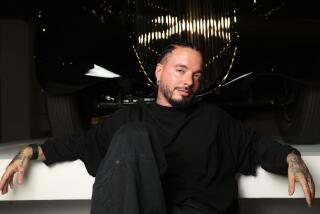Stayin’ Alive in the ‘90s
Jon B’s first hit was a duet with urban superstar Babyface. His current single “Are U Still Down” features vocals by the late rapper Tupac Shakur. R&B-pop; acts from Toni Braxton to Color Me Badd have recorded his songs.
How has this 23-year-old from Pasadena managed to make an impression on urban pop not seen from a white artist since the glory days of George Michael?
Blame it on the Bee Gees.
“That was R&B; music, I don’t care what anyone says,” asserts the singer-songwriter-producer with good-humored conviction, shifting his tall, skinny frame in a wooden chair during an interview at his Pasadena home studio.
“You’re talking about three white guys who had their hair permed out, with butterfly collars and the tans going on, in polyester suits, walking it.” He then playfully sings the opening line from the group’s 1978 hit “Stayin’ Alive.”
Where others might consider the Bee Gees’ mid-’70s foray into disco to be a strictly commercial move, Jon B found inspiration: “Those guys were doing their thing. They didn’t care what people thought or said.”
The young performer has taken this philosophy to heart. His languorous reserve and soft speaking tone belie a steely resolve to “keep it real,” i.e., be true to himself.
That’s a key component of maintaining credibility among the R&B; and hip-hop artists with whom he works, not to mention the audience that has signaled its approval for his sensual blend of ‘70s soul and ‘90s hip-hop by keeping his current album on Billboard’s R&B; charts for 40 weeks, where it’s holding at No. 8 (it’s No. 38 on the Top 200 album chart).
Approaching 1-million sales status, “Cool Relax” is his second collection on Yab Yum Records, the Sony/550 Music affiliate run by Tracey Edmonds, Babyface’s wife. Along with Babyface and Shakur, the album features collaborations with such urban heavyweights as A Tribe Called Quest’s Ali Shaheed Muhammed and the vocal duo K-Ci & JoJo.
Though it’s not unheard of, it is unusual for a white artist to make such a mark in R&B.; The term “rhythm & blues” itself has no hard-and-fast definition; historically, the Billboard R&B; charts have reflected everything that black record buyers liked: blues, jazz, swing, and eventually ‘50s rock ‘n’ roll tunes by such white artists as Elvis Presley and Carl Perkins, which often were reworked versions of black songs.
As R&B; expanded to encompass Motown, soul, funk, rap and hip-hop, a few white artists sporadically made the charts. As with Jon B today, the most obvious reason such acts as Wild Cherry, Bobby Caldwell and the George Michael-led Wham! crossed over was that they played styles that were popular among R&B; listeners of their eras. The music, not the artists’ race, was ultimately the main attraction.
To Edmonds, the quality of Jon B’s work was the only thing that mattered. “Songs and the art of songwriting have always been my central reason for signing an artist,” she says. “[Jon B’s] songs and the soulful emotion with which he delivered them immediately impressed me upon hearing his demo.”
She dismisses the idea that his color might have been a concern.
“I knew that with careful career planning, he was an artist who could be accepted by both the R&B; and pop audiences--regardless of color.”
Jon B certainly looks the part of the suave R&B; singer. At least after he changes from a tank top and sweatpants into a baggy dark blue suit for a photo shoot. He wears a variety of gold jewelry, and his dark hair and beard are closely cropped. Often expressing himself in hip-hop slang, he thoughtfully considers questions and seems a bit shy when responding, engaging the listener but not always making eye contact.
To him, keeping it real largely involves giving warm, deeply sexy voice to a seemingly inexhaustible supply of seduction sentiments, like the singles “Are U Still Down,” “Don’t Say” and the million-selling “They Don’t Know,” currently No. 8 among Billboard’s Hot 100 Singles.
Growing up, he heard a wide variety of pop music, thanks to his grandparents’ Palo Alto record store. Starting around age 5, he tried out everything from Rod Stewart to the Jackson 5.
Little Jon (whose last name is Buck) didn’t grasp the idea of genres, let alone fathom that they could be segregated by color. Born in Rhode Island and raised from age 4 in Pasadena, he is the middle child in a progressive, musical family. His father is a music professor at Cal State L.A., his mother a concert pianist. His older sister plays violin, and his younger brother is a cellist. Jon himself is fluent on keyboards, guitar, bass and drums.
He gravitated toward R&B; and soul, he says, because they “stuck out in influencing me: the hooks, the really catchy melodies, the rhythms that I loved to dance to.” But his passion made the teenage Jon B an object of occasional derision among fellow students at L.A. County High School for the Arts.
“[I was] the only white boy in a whole group of black kids that were listening to R&B; music and dancing,” says Buck, whose influences also include Marvin Gaye, Stevie Wonder and Prince in his slicker, romantic moments. “Whatever the [derogatory] names were, back in the day, they were coming from the black kids and the white kids.”
Persevering, he eventually found acceptance among his peers, whose positive responses to his songs during talent shows encouraged him to keep writing. Soon, at the ripe old age of 19, he was tapped by Edmonds to become the first artist on her Yab Yum roster. His gold-selling 1995 debut, “Bonafied,” got a boost many young artists would kill for, with Babyface penning two singles: the Top-10 pop and R&B; hit “Someone to Love,” on which Babyface also sang, and the Top 40-grazing “Pretty Girl.”
Jon B says his skin color might pique curiosity, but people like his music “because the songs are relatable and I’ve made an effort to stay up with the times. That’s the main thing, not so much the white thing. Teena Marie, Michael McDonald, the Bee Gees--in their time, they got respect because of their music.”
But he has encountered discrimination, or at least suspicion, over things that wouldn’t be issues if he were African American. For example, he says, black women appear in his videos, and “people are so hung up on that.”
He has been questioned about it, he says, by both black and white women who want to know if he would get romantically involved with an African American woman in real life.
“That’s real to the way I’m living,” he says. “The woman I can relate to right now is a black woman.” First he confirms that the young woman hanging out with his publicist in the next room is his girlfriend, then retracts the use of “girlfriend” to describe the relationship. But he does concede that they are serious.
He notes that although he has encountered occasional flak from individuals, entertainment companies such as the cable channel BET have shown “virtually no kind of concern about the fact that I’m Caucasian. It’s such a worthless road, because once you travel down it, you realize it doesn’t matter.”
Still, Michelle Santosuosso, program director for Los Angeles R&B; radio station KKBT-FM (“the Beat”), believes that Jon B’s race could have been a liability for him with urban radio.
“The fact that he’s a white guy singing really black records . . . could have been an obstacle for him,” says Santosuosso, whose station’s current rotation includes “They Don’t Know,” “Are U Still Down” and “Keep It Real,” a duet from the “Hav Plenty” soundtrack with Coko from the female urban trio SWV.
But Yab Yum “was really smart at marketing him,” she says. “They didn’t sweep the fact that he was white under the rug,” putting him front-and-center in his early videos, for example.
Santosuosso feels the strategy worked, and says “the Beat” has experienced no negative reaction from playing him. In fact, Jon B will be on the bill at the station’s Summer Jam concert on Aug. 9 at Irvine Meadows Amphitheatre.
Santosuosso emphasizes that Jon B’s appeal goes beyond skin color. “The more rare thing about him, the reason he’s so successful,” she says, “is that he’s able to write great songs.”
His knack for hooking up with winning collaborators hasn’t hurt him, either. But now he’s taking more artistic initiative, co-directing his videos in the hopes of directing them one day, and trying to decide whether to go it alone on his next album, even though he loves the give-and-take of working with others.
“Collaborations are the best,” he says. “I think people wanna see somebody like Tupac and Jon B do their thing, because it’s not even thought of, man, no one would expect [it]. Even on a racial level, people don’t see that many black people and white people doing things together these days.”
While he concedes that Shakur might have been partly motivated by the novelty of crossing the color line, Jon B maintains there was more to their collaboration. “When he hooked up with me, it was about mutual respect. And the same back.”
“Are U Still Down” was finished in one three-hour recording session. Shakur was shot in Las Vegas just two weeks later, but their encounter is still treasured by Jon B, who says he has become friends with the rapper’s family. “He sat me down and he said, ‘Don’t sit on your talent. Don’t wait to do stuff.’ He was right. And no one can hold me back from doing what I’ve always dreamed about.”
More to Read
The biggest entertainment stories
Get our big stories about Hollywood, film, television, music, arts, culture and more right in your inbox as soon as they publish.
You may occasionally receive promotional content from the Los Angeles Times.










